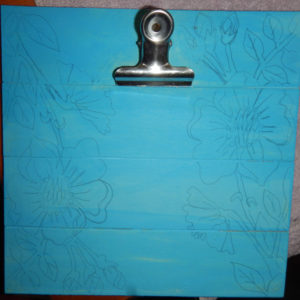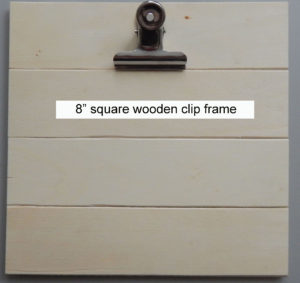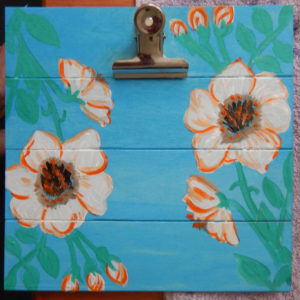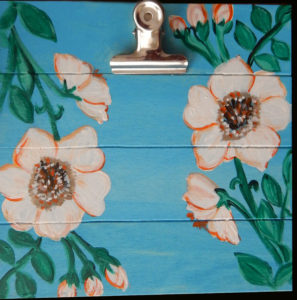Mobile Art Program
Since 2007, our Mobile Art instructors and volunteers have been visiting nursing homes, Alzheimer respite centers and adults living independently in Austin, Texas. Our 2020 summer classes were supposed to have taken place onsite at 8 different Housing Authority for the City of Austin (HACA) sites. Obviously, those plans have changed. Our long-term goal was to have a series of videos available for those adults in the community who otherwise would not have access to professionally run art classes. The COVID-19 situation has sped up our timeline.
The good news is that our Mobile Art Program Director, Theresa Zelazny, has prepared an art lesson which you can do at home. While the project is designed to be done on an 8” x 8” wooden surface, the design can be done on any 8” x 8” surface that will accept acrylic paint. It can also be done on paper with colored pencils or watercolor paints. The following instructions are written for those who have acrylic paints.An instructional video of this project is online.
Wildflower Wood Clip Frame
Instructional Video
Click here to view the video in a new browser window
Supply List
- Wooden photo holder with peg
- Acrylic paints
- Foam brush
- 3 paint brushes
- Tracing paper (alternative: https://www.wikihow.com/Trace-Without-Tracing-Paper)
- Line drawings (download pdf here)
- Cup for water
- Paper towels
- Pencil or pen (for tracing)
Line Drawing Templates
Click here to download PDF then print the PDF.
Setting Up Your Work Area
Acrylic paint will not wash out of fabric, we suggest that you wear something that you do not mind getting paint on.
- Place a piece of newspaper or paper towels over the work area.
- Have a cup of water and paper towels on hand.
- Use a plastic plate or piece of cardboard as your paint palette.
- Acrylic paint dries quickly, so please be conservative when squeezing paint from the tube.
Instructions
Step 1: Painting the Background
- Choose a background color for your project
- Squeeze a half dollar size amount of the color on your plate.
- Using the foam brush, add a small amount of water to the brush then dip the brush into the paint.
- Begin painting the wood surface.
- The wood will absorb the paint quickly. Continue to paint, as you get close to the metal clip, leave a little gap of unpainted wood.
- Add paint as needed to your plate.
- When you are done, clean your foam brush.
- Use a medium size paintbrush to finish the area around the metal clip.
- Clean your brush and allow the surface to dry.

Step 2: Tracing a Design onto the Background
- Choose a design.
- Fold the paper design over the edge of the board and slip the tracing paper, dark side down, between the design and the wood.
- Using the tracing paper and pencil, trace the design onto the painted surface.
- Hold the paper in place with one hand while you trace the design, checking occasionally to make sure you are applying enough pressure.
- Do you want the design to be on both sides of the board? I decided that I wanted to repeat the design, so I flipped the design over and traced it to the opposite side of my board.
- When you are through tracing, put the tracing paper away as you can use it again for future projects.
- Keep the design at hand as you can refer to it as you begin painting.
Step 3: Painting Your Design
- I recommend you begin with the largest area first, in my example, it is white. I placed a half-dollar size amount of white on your plate.
- Use the largest brush to begin.
- Paint all the areas on the design that is your main color.
- Acrylic paint can be transparent, don’t be frustrated if the first coat is not as intense as you would like, you can go over the area again after it has dried.
- Use a contrasting color—in my example I used a tiny amount of brown and mixed it with white to create a tan, then painted around the center of the flower with the tan.
- What color is the center of your flower? Use the paint color out of the tube without mixing in any white. For my example, I used a dark brown.
- For the green leaves and stems mix white to the green to create a light shade of green.
- Use your medium size paintbrush to paint the leaves and stems a solid color.
- To add texture to my flower petals, I used a light orange. If you do not have a tube of orange in your paint set, you can make orange by mixing a bit of red to yellow. Don’t add too much red as it can overpower the yellow.
- Using the medium size brush, and looking at the design, add brushstrokes of color to the flower petals.
- Use the same color in the center of your flower.
- Using the small brush, apply the green paint to add details to the stems and leaves.
Step 4: Final Touches
- You are almost done – hold your project at arm’s length. Do you see any areas that need improvement?
- I felt mine was too orange, so we went over the petals again with white paint to tone down the orange.
- The final revision I made was to add more contrast to the leaves and stems by mixing white with the green.
Step 5: Displaying Your Work
- Your wood clip frame is ready to use. Place the peg into the hole in the back and display your beautiful project with pride!
Cleaning Up
Cleaning your brushes after use:
- Wash your brushes with warm soapy water right after your painting session ends, rubbing it in circles on the palm of your hand. Make sure you clean between the bristles too, especially the area close to the metal area of the handle. Rinse well, squeeze it dry, and then re-shape the brush. Let your brush dry horizontally.
- The foam brush can be rinsed out and saved for future projects.
We can’t wait to see what you come up with for this project! We look forward to sending you more projects while we are all staying at home, and we hope to have in-person classes resume this summer.
Theresa Zelazny
mobileart@mail.org
Mobile Art Program Director
Art Spark Texas



